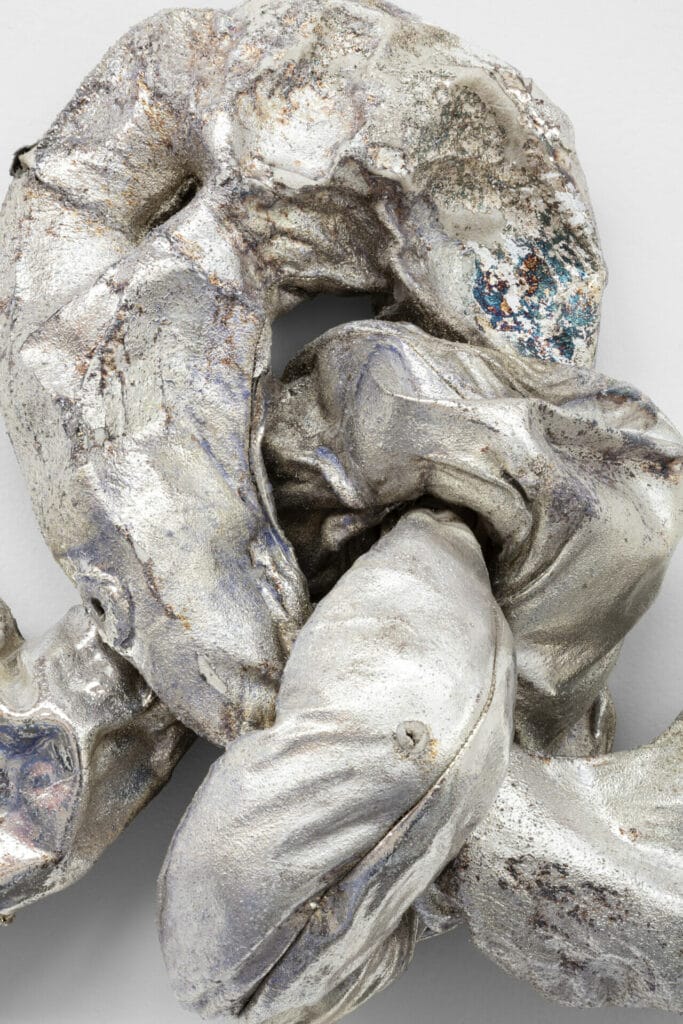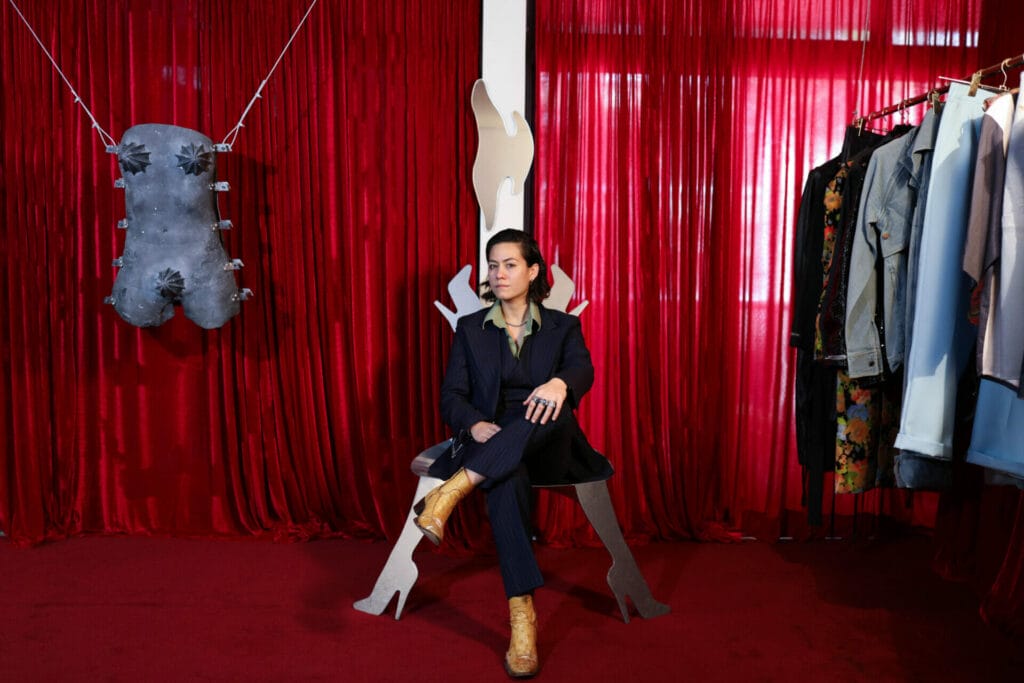Into clothing is transposed the complex, stratified and changeable relationship between personal experience and collective memory, between an intensely-lived past, minus nostalgia, and the future. The relative nature of certainty and outcome encourages us to wander through the future, to look forward, to make plans that are not simply mindless affirmation, but are a vital sweepstake about what is going to happen. You have to dream of growth to be able to grow.
–Gabi Scardi
kurimanzutto is delighted to present New Lexicons for Embodiment, the first-ever solo exhibition by Mexican artist and designer Barbara Sánchez-Kane in New York. Navigating the individual, yet intertwined worlds of fashion and art, the artist considers the clothed body as the interphase with which we experience the world and interact with reality, and examines how these clothes contribute to the performance of identity and self-expression.
Sánchez-Kane, who alternatively uses she and he pronouns, is interested in the deconstruction of identities and the duality of the presented self: through her clothes and sculptures, there is a perpetual tearing and fracturing of the structure, voids that seemingly shouldn’t exist, and the recurring repurposing of traditional objects through the destruction of their functionality.

As an introduction to Sánchez-Kane’s practice, the foyer of the gallery will house a pop-up shop of his fashion brand with items from his latest collection. This space will serve as an interlude into the art exhibition, which will in turn showcase her sculptural practice. Many of the works on show are based on a 1920s design treaty (The Koester School Book of Drapes), which ordered that plinths or structures selling goods were transformed into fashionable and desirable vitrines. For her presentation, she has studied these techniques and transformed them into sculptures in their own right. These objects, made from tissue, resemble infinite and organic landscapes where the “desirable goods” for sale are absent. These pieces in Sánchez-Kane’s project tackle the void and the empty space that would normally be occupied by objects and bodies, both materially and metaphorically.
Through the repetition of patterns with slight variations, the artist creates a number of possibilities of “wearable” sculptures. In the fashion industry, molds and repetition, pattern creation and weaving are central to production. The artist takes these ideas and constructs experimental structures that deform, expand and multiply different materials to create what she calls “monsters” that inhabit the gallery space.
Three hanging sculptures made of aluminum were created as a reaction to the dress form fitting system, where mannequins can be modified, enlarged, and stretched to simulate different body types for cloth-making. Sánchez-Kane creates abstract sculptures inspired by this anthropomorphic object, presenting deformed, stretched, and modifiable bodies that use the technology from the fitting system.

Art creates a space for the Sánchez-Kane to disarticulate the elements in the fashion industry with which he does not identify, such as the standardization of bodies through sizes, the ephemerality of tendencies, mass consumption, and fast fashion. On the other hand, fashion is the discipline in which she was trained, and the symbolic space where he organizes her ideas and understands the material world. Through these two lines of thought, Sánchez-Kane translates his observations into sculptural works that exit the fashion arena and reveal their impossibility to function inside it. In addition to the material expression of these observations, the pieces also raise questions about power dynamics that sustain the production, circulation, and consumption process that homogenize identity and marginalize bodies and beauty standards.
about Bárbara Sánchez-Kane
Bárbara Sánchez-Kane (1987, Mérida, Mexico) resists traditional notions of Mexican machismo through her ethos of the macho sentimental: a person who does not deny their natural impulses towards feminine and masculine forms of expression. Whether using her unisex fashion label Sánchez-Kane, or his installation, painting, performance, poetry, and sculpture practices, all of her works question hegemonic masculinity, the social construction of gender and sexual identity, and the ways in which each present themselves in daily life. Often addressing the role fashion plays in aiding these identities, Sánchez-Kane appropriates everyday objects and items of clothing that surround him to deconstruct, rebuild, and imbue them with new meaning. The outcome becomes a conceptual exchange between art and fashion that neutralizes the binary associations of objects, bodies, and symbols and underscores their performative nature.

Among Sánchez-Kane’s most recent group exhibitions are Nuestrxs Putxs, Human Resources, Los Angeles (2021); De por Vida, Company Gallery, New York (2021); En llamas, Llano, Mexico City (2021); Otrxs Mundxs, Museo Tamayo, Mexico City (2020–2021); SEÑORA!, Meyer Kainer Galerie, Austria (2020); and Prince/sses des villes, Palais de Tokyo, Paris (2019).
About kurimanzutto
Founded in 1999 by Mónica Manzutto and José Kuri, kurimanzutto’s primary aim was to promote the careers of the artists it represented and adapting to the projects it undertook. Initially a nomadic enterprise, its projects occupied disparate spaces across the urban landscape, and became the core of the first generation of artists’ practice. Later on, a warehouse was at the artists and gallery’s disposition for
different ventures that needed both an arena of freedom and unbound space. In 2008, kurimanzutto opened a permanent gallery space in Mexico City, yet the gallery continues to search for places outside the white cube to continue with its original vocation.
kurimanzutto opened gallery space on 520 w 20th street, New York City on November 2022. This marks an essential development for the gallery’s artists as a meeting point for their ideas. kurimanzutto in New York represents an extension of the original gallery in Mexico City: this reaffirms its mission to create new spaces and situations that will transmit the gallery’s spirit, where the artist is central to its existence. The project space in New York will act as a catalyst for a broad international program across North America.
kurimanzutto currently represents 38 international artists and is devoted to the development of their careers in the international art scene, placing their works in important public and private collections. It has also actively supported ambitious projects in museums and biennales, ensuring that the artists’ vision are transmitted as fully and effectively to the public as possible. Thanks to its extensive archive and proactive participation in publishing activities, the gallery is characterized as a meeting place open to criticism and research, welcoming the development of risky projects rarely seen in the context of a commercial gallery.

